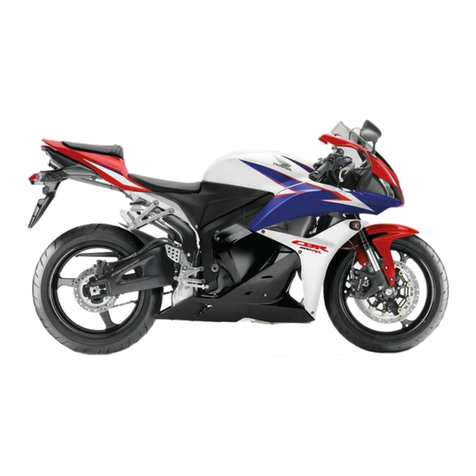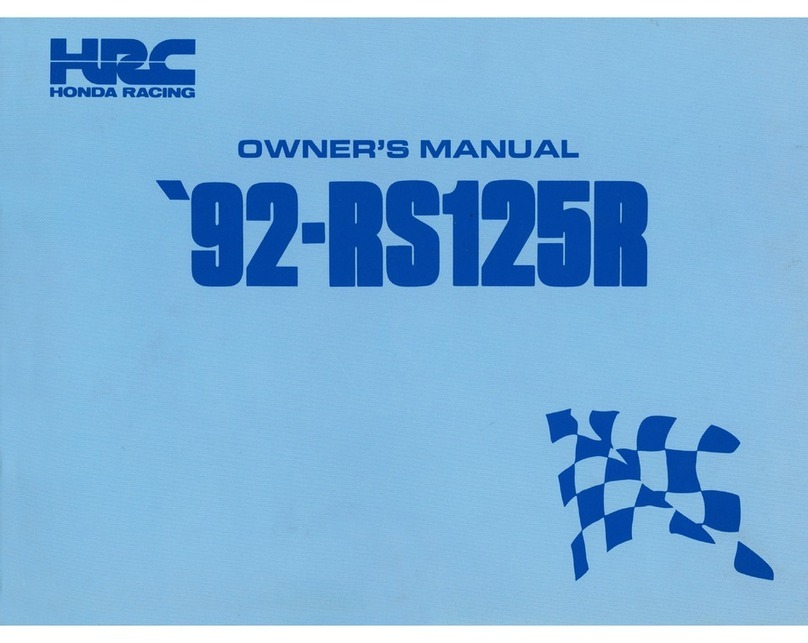Cleaning 3–24
Storage 3–24
Nuts, Bolts, Fasteners 3–25
4. Engine Servicing
Lubrication Diagram 4–1
Oil Pressure Relief Valve 4–2
Oil Pump 4–4
Fuel Hose Removal/Installation 4–7
Fuel Line Inspection 4–9
Fuel Tank/Fuel Pump 4–10
Throttle Body/Air Box 4–14
Muffler/Exhaust Pipe 4–20
Engine Removal 4–21
Engine Installation 4–21
Radiator Removal/Installation 4–24
Water Seal/Bearing Replacement 4–24
Cylinder Head Cover/Camshaft Removal 4–27
Cylinder Head Removal 4–30
Cylinder Head Disassembly 4–32
Cylinder Head Inspection 4–33
Cylinder Head Assembly 4–36
Cylinder Head Installation 4–37
Camshaft/Cylinder Head Cover Installation 4–38
Cylinder/Piston 4–43
Clutch 4–46
Right Crankcase Cover 4–51
Primary Drive Gear 4–52
Balancer 4–54
Transmission 4–56
Left Crankcase Cover 4–64
Flywheel 4–67
Crankcase Separation/Disassembly 4–68
Crankshaft 4–71
Crankcase Bearing Replacement 4–76
Crankcase Assembly 4–79
5. Frame Servicing
Front Wheel 5–1
Fork 5–4
Handlebar 5–13
Contents
1. Operating Instruction
Fuel 1–1
Coolant 1–1
Basic Operation 1–2
Controls 1–4
2. Service Data
Specifications 2–1
Service Data 2–2
Optional Parts 2–5
Torque Values 2–6
Tools 2–10
Lubrication & Seal Points 2–12
Cable & Harness Routing 2–15
3. Service And Maintenance
Maintenance Schedule 3–1
Pre-ride Inspection 3–1
Warming-up Inspection 3–2
Ride Inspection 3–2
After Ride Inspection 3–2
Replacement Parts 3–2
Fuel Line 3–4
Air Filter 3–4
Spark Plug 3–4
Valve Clearance 3–5
Engine Oil 3–8
Transmission Oil 3–10
Cooling System 3–12
Clutch System 3–13
Exhaust Pipe/Muffler 3–14
Drive Chain 3–15
Drive Chain Slider/Roller 3–16
Drive/Driven Sprocket 3–17
Brake Fluid 3–19
Brake Pad Wear 3–19
Brake System 3–20
Handlebar And Steering Head Bearings 3–20
Wheels/Tires 3–21
Front Suspension 3–21
Fork 3–22
Rear Suspension 3–22
Steering Stem 5–14
Rear Wheel 5–19
Rear Shock Absorber 5–20
Suspension Linkage 5–24
Swingarm 5–25
Brake Pad Replacement 5–32
Front Brake Caliper 5–35
Rear Brake Caliper 5–35
Front Master Cylinder 5–37
Rear Master Cylinder 5–39
6. Electrical Servicing
Charging System Inspection 6–1
Ignition System Inspection 6–2
Condenser Inspection 6–4
Engine Stop Switch Inspection 6–4
Handle Switch Inspection 6–5
PGM-FI System Inspection 6–5
PGM-FI System Self-diagnosis Procedure 6–6
PGM-FI Self-diagnosis Malfunction
Indicator Lamp (MIL) Failure Codes 6–7
Bank Angle Sensor Inspection 6–8
Coolant Temperature Sensor Inspection 6–9
Wiring Diagram 6–10
7. Machine Setting
Optional Transmission Gear 7–1
Suspension Setting 7–7
Suspension Setting Troubleshooting 7–14































